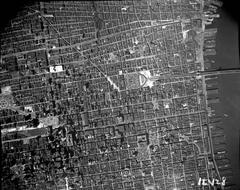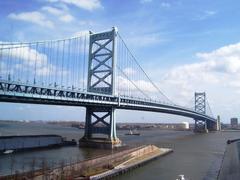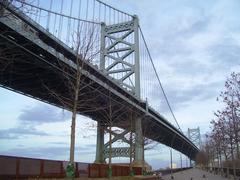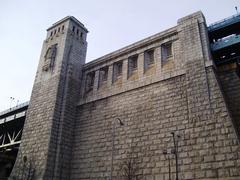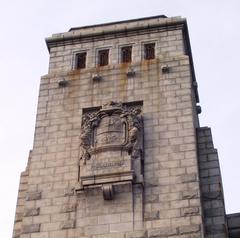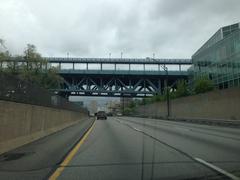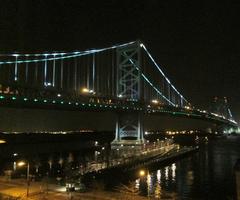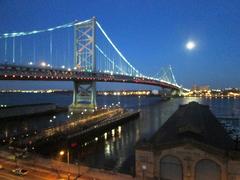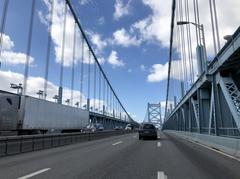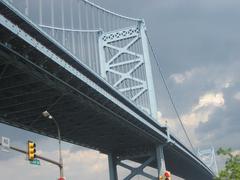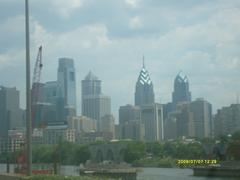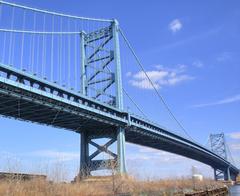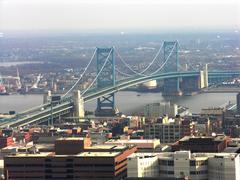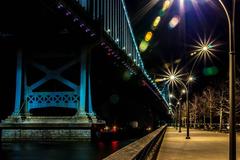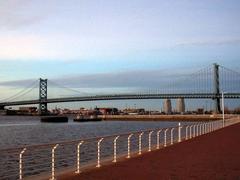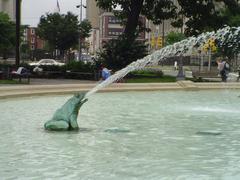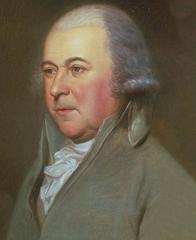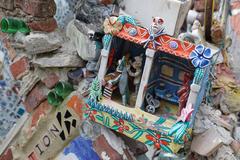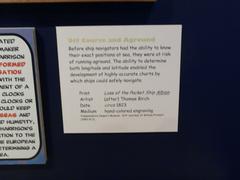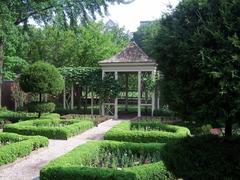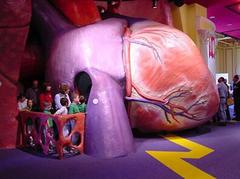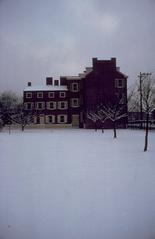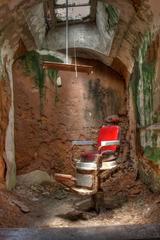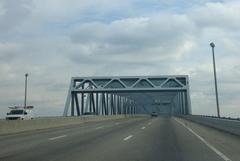
Visiting Benjamin Franklin Bridge: Tickets, Hours, and Travel Tips
Date: 23/07/2024
Introduction
The Benjamin Franklin Bridge, an iconic suspension bridge connecting Philadelphia, Pennsylvania, to Camden, New Jersey, is a marvel of early 20th-century engineering. Initially opened in 1926 as the Delaware River Bridge, it was the longest suspension bridge in the world at the time, with a main span of 1,750 feet (Delaware River Port Authority). Designed by the esteemed engineer Ralph Modjeski, who also worked on the Manhattan Bridge, this architectural feat has stood the test of time and remains a critical transportation link and historical landmark. The bridge was renamed in 1955 to honor Benjamin Franklin, one of America’s Founding Fathers and a prominent figure in Philadelphia’s history (Structurae). Today, it not only facilitates the movement of over 100,000 vehicles daily but also stands as a symbol of progress and innovation, attracting countless visitors who come to admire its grandeur and enjoy the breathtaking views it offers of the Philadelphia skyline and the Delaware River (Visit Philadelphia).
Table of Contents
- Introduction
- History of the Benjamin Franklin Bridge
- Visitor Information
- Nearby Attractions
- Accessibility
- Special Events and Guided Tours
- Cultural and Social Impact
- Preservation and Future Plans
- Frequently Asked Questions (FAQ)
- Conclusion
History of the Benjamin Franklin Bridge
Early Planning and Construction
The Benjamin Franklin Bridge, originally named the Delaware River Bridge, was conceived in the early 20th century to address the growing need for a direct connection between Philadelphia, Pennsylvania, and Camden, New Jersey. The idea for the bridge was first proposed in 1919, and after several years of planning and debate, construction began on January 6, 1922. The bridge was designed by renowned engineer Ralph Modjeski, who was known for his work on other significant bridges, including the Manhattan Bridge in New York City.
The construction of the bridge was a monumental task, involving thousands of workers and the use of innovative engineering techniques. The main span of the bridge, which measures 1,750 feet, was the longest suspension bridge span in the world at the time of its completion. The total length of the bridge is 9,573 feet, including the approaches. The bridge’s towers rise to a height of 380 feet above the water, and the roadway is suspended 135 feet above the river, allowing for the passage of large ships.
Opening and Early Years
The Benjamin Franklin Bridge was officially opened to traffic on July 1, 1926, in a grand ceremony attended by thousands of people, including President Calvin Coolidge. The opening of the bridge was a significant event, as it marked the culmination of years of planning and construction and represented a major achievement in engineering and transportation.
In its early years, the bridge was a toll bridge, with a toll of 25 cents for automobiles and 15 cents for pedestrians. The bridge quickly became a vital transportation link, facilitating the movement of people and goods between Philadelphia and Camden and contributing to the economic growth of both cities. The bridge also played a key role in the development of the surrounding areas, as it made it easier for people to commute between the two cities and encouraged the growth of suburban communities.
Renaming and Later Developments
In 1955, the Delaware River Bridge was renamed the Benjamin Franklin Bridge in honor of Benjamin Franklin, one of the Founding Fathers of the United States and a prominent figure in Philadelphia’s history. The renaming was part of a broader effort to recognize Franklin’s contributions to the city and the nation.
Over the years, the bridge has undergone several renovations and upgrades to ensure its continued safety and functionality. In the 1950s and 1960s, the bridge was widened to accommodate increased traffic, and in the 1980s, a major rehabilitation project was undertaken to address structural issues and modernize the bridge’s facilities. This project included the replacement of the bridge’s deck, the installation of new lighting and signage, and the refurbishment of the bridge’s towers and cables.
Visitor Information
Visiting Hours and Tickets
The Benjamin Franklin Bridge is open to pedestrians and cyclists daily from 6 AM to 9 PM. There is no fee to walk or cycle across the bridge, making it an accessible attraction for all visitors. For those driving, tolls are collected only for westbound traffic heading into Philadelphia.
Travel Tips
- Best Times to Visit: Early mornings and late afternoons are ideal for avoiding heavy traffic and enjoying a peaceful stroll or bike ride with stunning views.
- Photography Spots: The pedestrian walkways offer fantastic vantage points for capturing the Philadelphia skyline and the Delaware River.
- Safety: Always stay within designated pedestrian and cycling lanes. The bridge can be windy, so dress accordingly.
Nearby Attractions
Philadelphia Side
- Independence Hall: Located just a short distance from the Philadelphia side of the bridge, this historic site is where the Declaration of Independence and the Constitution were signed.
- Race Street Pier: A scenic park located under the bridge on the Philadelphia side, perfect for relaxation and picnics.
Camden Side
- Adventure Aquarium: Situated near the Camden side, this family-friendly attraction features a variety of marine life exhibits.
Accessibility
The Benjamin Franklin Bridge is accessible to pedestrians, cyclists, and vehicles. Elevators are available at certain points to assist those with limited mobility. The bridge’s walkways are well-maintained, ensuring a safe and enjoyable experience for all visitors.
Special Events and Guided Tours
Throughout the year, the Delaware River Port Authority hosts special events and guided tours that offer unique insights into the bridge’s history and engineering. Check their official website for the latest information on upcoming events and tours.
Cultural and Social Impact
The Benjamin Franklin Bridge has had a significant cultural and social impact. The bridge is an iconic symbol of Philadelphia and Camden, and its distinctive blue towers and graceful suspension cables are recognizable landmarks. The bridge has been featured in numerous films, television shows, and works of art, and it continues to be a popular subject for photographers and artists.
The bridge is also a popular destination for pedestrians and cyclists, who can enjoy stunning views of the Philadelphia skyline and the Delaware River from the bridge’s walkways. The bridge’s pedestrian walkways were closed for several years in the 1970s and 1980s due to safety concerns, but they were reopened in the 1990s after the completion of the bridge’s rehabilitation project. Today, the walkways are a popular spot for recreational activities and offer a unique perspective on the bridge and its surroundings.
Preservation and Future Plans
Efforts to preserve and maintain the Benjamin Franklin Bridge are ongoing. The Delaware River Port Authority, which owns and operates the bridge, has undertaken several projects in recent years to ensure the bridge’s continued safety and functionality. These projects include regular inspections and maintenance, as well as larger-scale rehabilitation and modernization efforts.
Looking to the future, the Delaware River Port Authority has plans to further enhance the bridge’s facilities and improve its accessibility for pedestrians and cyclists. These plans include the installation of new lighting and signage, the refurbishment of the bridge’s walkways, and the development of new recreational and educational programs to highlight the bridge’s history and significance.
The Benjamin Franklin Bridge remains a vital transportation link and an iconic symbol of the Philadelphia-Camden metropolitan area. Its history and significance continue to be celebrated and preserved, ensuring that future generations can appreciate and enjoy this remarkable engineering achievement.
Frequently Asked Questions (FAQ)
Q: What are the visiting hours for the Benjamin Franklin Bridge?
A: The bridge is open to pedestrians and cyclists daily from 6 AM to 9 PM.
Q: Is there a fee to walk or cycle across the Benjamin Franklin Bridge?
A: No, there is no fee for pedestrians and cyclists. Tolls are collected only for westbound vehicle traffic.
Q: Are there any guided tours available?
A: Yes, the Delaware River Port Authority hosts special events and guided tours throughout the year. Check their official website for the latest information.
Q: What are some nearby attractions to visit?
A: Nearby attractions include Independence Hall, Adventure Aquarium, and Race Street Pier.
Q: Is the bridge accessible for people with limited mobility?
A: Yes, the bridge is accessible to all visitors, with elevators available at certain points to assist those with limited mobility.
Conclusion
The Benjamin Franklin Bridge serves as a testament to the ingenuity and determination of early 20th-century engineers and city planners. Its historical significance, architectural beauty, and vital role in connecting Philadelphia and Camden make it a must-visit destination for both locals and tourists. Whether you’re walking, cycling, or driving across this iconic structure, you’ll be treated to stunning views, rich historical context, and a tangible sense of the cultural bond it represents between the two cities. With ongoing preservation efforts and plans for future enhancements, the Benjamin Franklin Bridge will continue to be a symbol of engineering excellence and urban connectivity for generations to come. For more information on visiting hours, tours, and nearby attractions, be sure to check the Delaware River Port Authority’s official website and stay updated through their social media channels.
